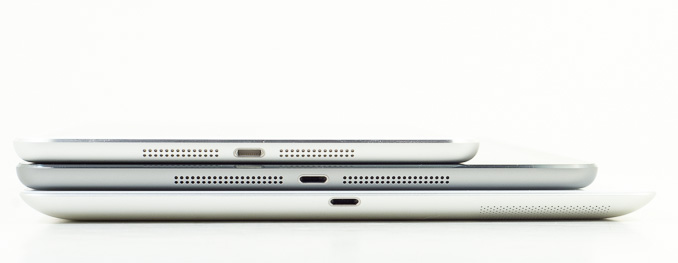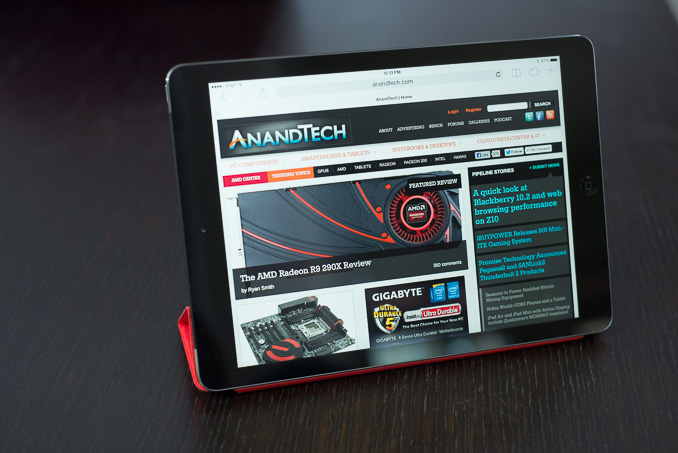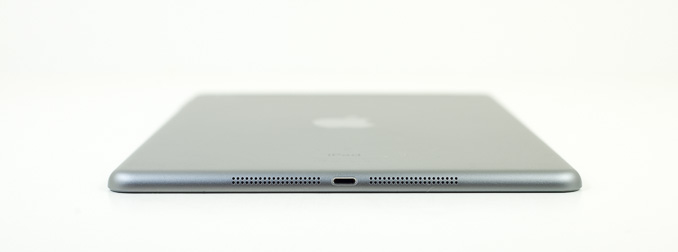The iPad Air Review
by Anand Lal Shimpi on October 29, 2013 9:00 PM ESTFinal Words
Two weeks ago I had all but written off the bigger iPad. It was too bulky and just no where near as portable as the iPad mini. Once the latter gets a Retina Display and equal hardware across the board, why would anyone consider the bigger model?
The iPad Air changed my perspective on all of that. It really does modernize the big iPad. While I suspect there are still going to be a lot of users who prefer the smaller form factor of the iPad mini with Retina Display, I do feel like there are those users who will continue to appreciate all of the benefits that go along with having a larger display. Text is easier to read, particularly on desktop versions of websites. Photos and videos are larger and thus more engaging as well. In the past there was this complex matrix of tradeoffs that you had to make between iPad and iPad mini. This generation, Apple does away with all of that.
All you need to do is pick your screen size. If you prefer the 9.7-inch form factor of the original iPad, the Air gets you as close as possible to a mini without giving up that display size.

From top to bottom: iPad mini, iPad Air, iPad 4
The name does the product justice in this case. In two hands or lightly propped up against something (palm, legs, chest), the iPad Air feels incredibly light - the weight just seems to disappear. The larger chassis doesn’t feel very dense at all. The in-hand feel of the device is really unlike any other iPad. It feels like a lightweight slate, rather than a heavy computing device. This is the iPad that Apple likely wanted to launch on day 1, it just took a bit over three years to get here.
Build and material quality are of course excellent. The iPad Air borrows much of the design language from the iPad mini, and makes the transition to a larger display quite nicely. The Air ends up looking a lot more modern than its predecessor.
Despite making the transition to a thinner touch and display stack, the iPad Air’s display is every bit as good as previous Retina Display iterations. Color accuracy remains best in class, delivering an out of box display experience that’s better than most systems, even at substantially higher price points. The only thing that the iPad Air leaves me wanting on the display front is a lower reflectance stack. Laminating the cover glass to the LCD panel is something that Apple does on both the iPhone and iMac, it’s time that the same feature is brought down to the iPad.
Apple’s decision to unify silicon across the iPhone 5s, iPad Air and iPad mini with Retina Display is an interesting one, but ultimately it doesn’t come with any real tradeoffs for iPad owners. Apple’s own 64-bit Cyclone cores are incredibly powerful, even more so than I originally expected when I reviewed the iPhone 5s. Apple seems to have built a bigger, higher performance CPU architecture than any other ARM player, including ARM itself. The design isn’t perfect, but it’s a completely different caliber performer than anything else it competes against. As such, Apple was completely justified in putting the A7 in both the iPhone 5s and the iPad Air. If anything, I’d argue that it might be overkill for the 5s given the device’s smaller battery, but my sensibilities soon get the best of me and remind me that more performance on tap is never a bad thing.
On the GPU front, Apple does increase performance over the iPad 4 as well - despite having a narrower memory bus. The increase in performance ranges from 40 - 70% depending on workload. I suspect we’re beginning to see some of the limits of 28nm here as Apple would’ve traditionally gone for an even larger GPU.
Despite having a smaller/thinner/lighter battery, battery life improves across the board compared to the 3rd and 4th generation iPads. Battery life in our web browsing, video playback and gaming workloads is better than either of the previous two iPads. Only the iPad 2,4 was able to deliver better battery life, but nothing with a Retina Display can match the iPad.
Cellular integration remains awesome on the iPad Air. With a single SKU covering 34 countries and no network operator lock, at least for those devices sold in the US, the LTE iPad Air is amazingly flexible from a network portability standpoint.
Improvements around the edges are nice as well. The inclusion of a second microphone can improve FaceTime HD calls in noisy environments, and faster WiFi is a nice addition.
My only complaints are limited to iOS 7, memory size and pricing. It’s clear that even on the fastest hardware Apple has to offer, iOS 7 isn’t always super smooth (particularly when using multitasking gestures to switch between apps) on an ultra high resolution device. The move to a 64-bit OS and applications makes a lot of sense, but with no corresponding increase in DRAM size Apple creates additional memory pressure on all of the A7 enabled devices. Finally, I’d love to see Apple update the default iPad configurations. Although 16GB is fine for a device that’s not going to be storing a ton of photos/videos locally, it would really be nice to get at least 32GB on the entry level iPad. The first complaint I suspect will be addressed over time. The second is a reality we just have to live with unfortunately, and the third won’t change until market dynamics force it to.
The iPad Air is the most significant upgrade to the 9.7-inch iPad in its history. It’s lighter, more portable, more usable and faster than any previous iPad. It doesn’t fundamentally change what you can do with a tablet, but if you’re in the market for one the iPad Air really is the best iPad to date. Competition is definitely more stiff among the smaller tablets thanks to the Nexus 7, but in the nearly 10-inch tablet space it seems like Apple is going to continue to enjoy a great position there.












444 Comments
View All Comments
tetsuk - Friday, November 15, 2013 - link
The Macbook Air is great. However, as you mentioned, iWork is not comparable to Office. Since bootcamp works really well, it could still be an option.syedjalalt - Tuesday, November 5, 2013 - link
AnandTech reviews are so unbiased and true unlike The Verge(iSheeps). They go as much deeper as possible to get the best out of their reviews and articles. This is real journalism. Hats off.johned - Tuesday, November 5, 2013 - link
I have a Nexus 4 (soon to be 5) a Nexus 7 first gen and an iPad 2 (soon to be Air). Sometimes I find all the partisan bickering about this stuff hilarious. I like a good row as much as the next guy but I'm a geek. I just love to play with the stuff. I prefer Android to iOS for my daily driver phone, but come on. Anand seems like he's just like me. He loves the tech, all of it, and if had could articulate the way he does, I probably would've started a website like this myself.I will say this, I really don't understand why people think NFC is dead. I use it at least once a day with Google Wallet on my phone. Both major grocery store chains in my area take it. McDonald's takes it. Now, the carrier based service is tanking because they were greedy and botched it. Google wallet I find very useful, though.
Also, I've never had problems transferring files with it. My brother-in-law has a VZW Droid M and I have Nexus devices and I've sent him files from both my tablet and my phone. The most useful thing about it compared to Apple's Air Drop service is that I can do this without needing a wifi connection.
I can honestly say, that the one thing keeping me from an iPhone right now is NFC because I use it so much. If the 5s had included it, I would be sporting one right now. Google Wallet is already available for iOS.
I keep seeing somebody in here sounding like the Apple App Store marketing manager spewing the tired old line about 400blah blah thousand "iPad optimized" apps. This is nice that they are doing that but I observe two things.
1) Google is trying to standardize apps so that 1 app needs to be made for all devices. Since all current Nexus devices have either a 720p or 1080p display, this is easy. This is simply a different approach than Apple is taking.
2)This means that I only need to buy every app 1 time instead of buying it once for my phone and again (usually for a higher price) on my tablet. Apple could mitigate this buy shipping a standard hi-def resolution on the iPhone which they seem reluctant to do.
Back to the original point. We are all geeks here. I appreciate technology. I have opinions about what I like and don't like, but I come to Anandtech because I like to stay current on everything going on. This site also stays largely unpolitical and sticks to the tech, which is why I don't read Ars as much anymore.
JTravers - Wednesday, November 6, 2013 - link
Not sure what you mean about needing a wifi connection for AirDrop. Is having your wifi turned on an issue? AirDrop uses wifi direct, so although you do need to have your wifi turned on you don't need to be connected to a wifi hotspot.nedjinski - Tuesday, November 5, 2013 - link
but wait - there's more -http://www.displaymate.com/Tablet_ShootOut_3.htm
Mayuyu - Wednesday, November 6, 2013 - link
IGZO display instead of IPS. The chart here is wrong.cheshirster - Wednesday, November 6, 2013 - link
Windows tablets are going to suppress ipads sales in coming months.Still no mention in conclusion. That's hilarious, at some point.
AngryCorgi - Thursday, November 14, 2013 - link
Again, you are listing the #s for GFLOPS/core, not the total GPU GFLOPS on the Rogue chips. You need to clarify that. And the older 554MP4 was 21.6 GFLOPS @ 300MHz (14.4 GFLOPS @ 200MHz, as ID'd by Imagination Tech).Atlink - Saturday, November 30, 2013 - link
I'm truly not trying to stir the pot at all, but I am curious about NFC. I understand what it is, and its possible application, however, I'm not seeing anyone really clamor for it. This whole NFC deal seems like the HD-DVD/Blu-Ray war all over again. Neither side really had a lead until Sony began to tip the scales in their favor due to the PS3's exclusive use of Blu-Ray discs for games.I understand that NFC can be used to do some neat things: pay for food, verify a subway ticket, check into a hotel, etc. The problem that I'm seeing is one that anyone without a NFC phone can see: the lack of NFC-enabled terminals. I would say that Apple is dropping the ball something fierce if there were NFC terminals to scan this and that almost everywhere, but like QR codes, they seem almost like a novelty. I *could* scan that code with my phone by either downloading an application that can do it, and then hoping that the code can be read by the program, and hoping that the URL is worth looking at... or I could just type in the URL right below it (yes, I know not everything has a short URL below it). I *could* use NFC by sitting down with my credit cards in advance, creating an account, punching in the numbers, verifying data, opening the app when needed, sorting through the cards I plan to use, selecting the correct one, ensuring the transaction was accepted by the POS... or I could just use my debit card like I have been doing for years now, swipe once, punch in my PIN, and be done with it.
Like I said, I do think that NFC is a really neat idea, and I would love the saturation to become more prevalent in the US, but as of now, it's kind of a neat idea with no real, practical application. I guess the problem I'm having is trying to understand the importance of having it NOW. Some people use NFC as a selling point, and that just seems odd.
I think that when NFC catches on, and you begin seeing it almost everywhere, then we'll start seeing it in Apple products. No point in putting something in if you aren't going to be able to use it, right?
divps - Saturday, November 30, 2013 - link
I have a Nexus 7 and use an iPhone 5. We also have the iPads, a Nexus 4, a Nexus 5 and a Galaxy Nexus phones in the household. I use the Nexus 7 as my tablet for the things that it is strong at and use the nice iOS ecosystem for Apps that I need and that's generally good enough for me. I like the idea of wireless charging and I'm going to get a wireless charger for the Nexus 4 and Nexus 5. The Micro-USB connector isn't the easiest thing to connect without a little effort and the connector can get fatigued over time. It's also nice if you can just come home and put the phone on the platform and pick it up when you need it. The Apple connector is a lot easier for me to put in but wireless charging would mean that I wouldn't need as many lightning cables at home.The Apple ecosystem is generally smoother and nicer. I recently upgraded my Nexus 7 to KitKat and it ran like a dog and I tried a bunch of things and eventually had to do a factory reset which means that I lost a bunch of things and had to re-add them. There are several threads on this on the Phandroid Nexus 7 forums. The iOS 7 upgrade was a piece of cake compared to the KitKat upgrade. I also found UI differences for some simple things between the Nexus 5 and Nexus 7 on KitKat. On the Nexus 7, you do left and right pulldown for notifications and settings. On the Nexus 7, you do one-finger and two-finger pulldowns for notifications and settings. I had thought that the UIs would be the same but I guess not.
I'm extremely impressed with the Nexus 5 hardware - it's very, very fast, great screen, very thin, good feel in hand. I don't like the layout of the volume control and it has known problems with shutter lag and audio output (which I hope will be fixed with software). It's an incredible value for the money.
The thing that I like about Android is the ease of copying content over to them. You just plug them into a PC and drag and drop your files and the Apps will find them on the device. With iOS, I have to convert videos to MP4, or documents to an iBooks compatible format.
I think that the music player and email apps on iOS are far better than the OS provided ones on Android. Google should have done a better job copying iOS Apps there.